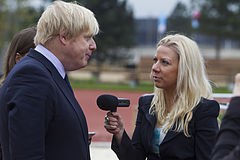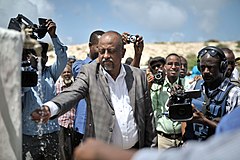Journalist
 | |
| Occupation | |
|---|---|
| Names | Journalist |
Occupation type | Journalism,mass media |
Activity sectors | Mass media,public relations,politics,sports,business |
| Description | |
| Competencies | Writing skills,interpersonal skills |
Education required | Typically abachelor's degree |
Fields of employment | Mass media |
Related jobs | Correspondent,columnist,spokesperson,politician |

Ajournalistis a person who gathers information in the form of text, audio or pictures, processes it into anewsworthyform and disseminates it to the public. This is calledjournalism.
Roles
[edit]Journalists can be broadcast, print, advertising or public relations personnel. Depending on the form of journalism, "journalist" may also describe various categories of people by the roles they play in the process. These includes reporters,correspondents,citizen journalist,editors,editorial writers,columnistsandphotojournalists.
Areporteris a type of journalist whoresearches,writes and reports on information in order to present usingsources.This may entail conductinginterviews,information-gathering and/or writing articles. Reporters may split their time between working in anewsroom,from home or outside to witness events or interviewing people. Reporters may be assigned a specificbeat(area of coverage).
Matthew C. Nisbet,who has written onscience communication,[1]has defined a "knowledge journalist" as apublic intellectualwho, likeWalter Lippmann,Fareed Zakaria,Naomi Klein,Michael Pollan,andAndrew Revkin,sees their role as researching complicated issues of fact or science which mostlaymenwould not have the time or access toinformationto research themselves, then communicating an accurate and understandable version to the public as a teacher and policy advisor.
In his best-known books,Public Opinion(1922) andThe Phantom Public(1925), Lippmann argued that most people lacked the capacity, time and motivation to follow and analyze news of the many complex policy questions that troubled society. Nor did they often experience most social problems or directly access expert insights. These limitations were made worse by a news media that tended to oversimplify issues and to reinforcestereotypes,partisan viewpoints andprejudices.As a consequence, Lippmann believed that the public needed journalists like himself who could serve as expert analysts, guiding "citizens to a deeper understanding of what was really important".[2]
In 2018, theUnited States Department of Labor'sOccupational Outlook Handbook reported that employment for the category "reporters, correspondents and broadcast news analysts" will decline 9 percent between 2016 and 2026.[3]
Modern overview
[edit]A worldwide sample of 27,500 journalists in 67 countries in 2012–2016 produced the following profile:[4]
- 57 percent male;
- meanage of 38
- mean years of experience, 13
- college degree, 56 percent
- graduate degree, 29 percent
- 61 percent specialized in journalism/communications at college
- 62 percent identified as generalists
- 23 percent specialized as hard-news beat journalists
- 47 percent were members of a professional association
- 80 percent worked full-time
- 50 percent worked in print, 23 percent on television, 17 percent on radio and 16 percent online.
In 2019 theReuters Institute for the Study of JournalismDigital News Report described the future for journalists inSouth Africaas “grim” because of low online revenue and plummeting advertising.[5]
In 2020Reporters Without Borderssecretary generalChristophe Deloiresaid journalists in developing countries were suffering political interference because theCOVID-19 pandemichad given governments around the world the chance “to take advantage of the fact that politics are on hold, the public is stunned and protests are out of the question, in order to impose measures that would be impossible in normal times”.[6]
In 2023 the closure of local newspapers in the US accelerated to an average of 2.5 per week, leaving more than 200 US counties as “news deserts” and meaning that more than half of all U.S. counties had limited access to reliable local news and information, according to researchers at theMedill School of Journalism, Media, Integrated Marketing CommunicationsatNorthwestern University.
In January 2024,The Los Angeles Times,Time magazine andNational Geographicall conducted layoffs, andCondé Nastjournalists went on strike over proposed job cuts.[7]The Los Angeles Times laid off more than 20% of the newsroom.[8] CNN,Sports IllustratedandNBC Newsshed employees in early 2024.[9]The New York Timesreported that Americans were suffering from “news fatigue” due to coverage of major news stories like theHamas attack,Russian invasion of Ukraineand thepresidential election.[9]American consumers turned away from journalists at legacy organizations associal mediabecame a common news source.[9]
Freedom
[edit]Journalists sometimes expose themselves to danger, particularly when reporting in areas ofarmed conflictor in states that do not respect thefreedom of the press.Organizationssuch as theCommittee to Protect JournalistsandReporters Without Borderspublish reports on press freedom and advocate for journalistic freedom. As of November 2011, the Committee to Protect Journalists reports that 887 journalists have been killed worldwide since 1992 bymurder(71%),crossfireorcombat(17%), or on dangerous assignment (11%). The "ten deadliest countries" for journalists since 1992 have beenIraq(230 deaths),Philippines(109),Russia(77),Colombia(76),Mexico(69),Algeria(61),Pakistan(59),India(49),Somalia(45),Brazil(31) andSri Lanka(30).[10]
The Committee to Protect Journalists also reports that as of 1 December 2010, 145 journalists were jailed worldwide for journalistic activities. Current numbers are even higher. The ten countries with the largest number of currently-imprisoned journalists areTurkey(95),[11]China(34),Iran(34),Eritrea(17),Burma(13),Uzbekistan(6),Vietnam(5),Cuba(4),Ethiopia(4) andSudan(3).[12]
Apart from physical harm, journalists are harmed psychologically. This applies especially to war reporters, but their editorial offices at home often do not know how to deal appropriately with the reporters they expose to danger. Hence, a systematic and sustainable way of psychological support for traumatized journalists is strongly needed. Few and fragmented support programs exist so far.[13]
On 8 August 2023, Iran's Journalists' Day, Tehran Journalists' Association head Akbar Montajabi noted over 100 journalists arrested amid protests, while HamMihan newspaper exposed repression against 76 media workers since September 2022 following Mahsa Amini's death-triggered mass protests, leading to legal consequences for journalists including Niloufar Hamedi and Elaheh.[14]
Relationship with sources
[edit]The relationship between a professional journalist and a source can be rather complex, and a source can sometimes have an effect on an article written by the journalist. The article 'A Compromised Fourth Estate' uses Herbert Gans' metaphor to capture their relationship. He uses a dance metaphor, "The Tango", to illustrate the co-operative nature of their interactions inasmuch as "It takes two to tango". Herbert suggests that the source often leads, but journalists commonly object to this notion for two reasons:
- It signals source supremacy in news making.
- It offends journalists' professional culture, which emphasizes independence and editorial autonomy.
The dance metaphor goes on to state:
A relationship with sources that istoo cozyis potentially compromising of journalists' integrity and risks becoming collusive. Journalists have typically favored a more robust, conflict model, based on a crucial assumption that if the media are to function as watchdogs of powerful economic and political interests, journalists must establish their independence of sources or risk the fourth estate being driven by the fifth estate of public relations.[15]
Safety
[edit]Journalists can face violence and intimidation for exercising theirfundamental righttofreedom of expression.The range of threats they are confronted with include murder,kidnapping,hostage-taking, offline and online harassment,intimidation,enforced disappearances, arbitrary detention and torture.Women in journalismalso face specific dangers and are especially vulnerable to sexual assault, whether in the form of a targeted sexual violation, often in reprisal for their work. Mob-related sexual violence aimed against journalists covering public events; or the sexual abuse of journalists in detention or captivity. Many of these crimes are not reported as a result of powerful cultural and professional stigmas.[16][17]
Increasingly, journalists (particularly women) are abused and harassed online, viahate speech,cyber-bullying,cyber-stalking,doxing, trolling,public shaming,intimidation and threats.[17]
Most dangerous year
[edit]
According toReporters Without Borders' 2018 annual report, it was the worst year on record for deadly violence and abuse toward journalists; there was a 15 percent increase in such killings since 2017, with 80 killed, 348 imprisoned and 60 held hostage.[18][19]
Yaser Murtajawas shot by an Israeli army sniper. Rubén Pat was gunned down outside a beach bar in Mexico. Mexico was described by Reporters Without Borders as "one of world's deadliest countries for the media"; 90% of attacks on journalists in the country reportedly go unsolved.[20]BulgarianVictoria Marinovawas beaten, raped and strangled. Saudi Arabian dissidentJamal Khashoggiwas killed inside Saudi Arabia's consulate in Istanbul.[21]
Commemoration
[edit]From 2008 to 2019,Freedom Forum's now-defunctNewseuminWashington, D.C.featured a Journalists Memorial which honored several thousand journalists around the world who had died or were killed while reporting the news.[22]After the Newseum closed in December 2019, supporters of freedom of the press persuaded theUnited States Congressin December 2020 to authorize the construction of a memorial to fallen journalists on public land with private funds.[22]By May 2023, theFallen Journalists Memorial Foundationhad begun the design of the memorial.[23]
Education
[edit]In the US, nearly all journalists have attended university, but only about halfmajoredin journalism.[24][25]Journalists who work in television or for newspapers are more likely to have studied journalism in college than journalists working for thewire services,inradio,or fornews magazines.[25]
Gallery
[edit]-
A program director sets the task for TV journalists, 1998.
-
A reporter interviews a man inHelmand Province,Afghanistan, 2009.
-
Journalist interviews acosplayer,2012.
-
A reporter interviewingBoris Johnsonwhen he was Mayor of London, 2014
-
Official tastes the water of a new well in front of journalists inMogadishu, Somalia,2014.
-
Cameraman and journalist who interviews a person in Austria
See also
[edit]References
[edit]- ^Nisbet, Matthew C. (March–April 2009)."Communicating Climate Change: Why Frames Matter for Public Engagement".Environment Magazine.Heldref Publications.Taylor & Francis Group.Archived fromthe originalon 3 July 2018.Retrieved9 March2019.
- ^Nisbet, Matthew C. (March 2013)."Nature's Prophet: Bill McKibben as Journalist, Public Intellectual and Activist"(PDF).Discussion Paper Series #D-78.Joan Shorenstein Center on the Press, Politics and Public Policy,School of Communication and the Center for Social MediaAmerican University.p. 7.Retrieved8 March2013.
- ^Talton, Jon (31 January 2018)."Occupational outlook: Where the big bucks are – and aren't".The Seattle Times.Retrieved1 February2018.
- ^Thomas Hanitzsch, et al. eds.Worlds of Journalism: Journalistic Cultures around the Globe(2019) pp. 73–74.see excerpt
- ^"Reuters Institute Digital News Report 2019"(PDF).Reuters Institute for the Study of Journalism.Thomson Reuters.
- ^Ahmed, Kaamil (6 May 2020). "Covid-19 could trigger 'media extinction event' in developing countries".The Guardian.
- ^Fu, Angela (24 January 2024)."Tuesday was a bleak day for the media industry".Poynter.
- ^James, Meg (23 January 2024)."L.A. Times to lay off at least 115 people in the newsroom".L.A. Times.
- ^abcRobertson, Katie (24 January 2024)."The News About the News Business Is Getting Grimmer".New York Times.
- ^"1337 Journalists Killed".Committee to Protect Journalists.Retrieved28 August2012.
- ^"Number of Jailed Journalists Nearly Doubles in Turkey".Los Angeles Times.5 April 2012.Retrieved6 April2012.
- ^"Iran, China drive prison tally to 14-year high".Committee to Protect Journalists.8 December 2010.Retrieved18 November2011.
- ^Tabeling, Petra (24 December 2014)."Petra Tabeling: In crisis areas, journalists are at risk in physical and psychological terms".D + C.p. 15.Retrieved9 March2019.
- ^"Scores Of Media Workers Detained In Iran In Latest Protests Honored On Journalists' Day".RFERL ORG.8 August 2023.Retrieved16 August2023.
- ^Lewis, Justin; Williams, Andrew; Franklin, Bob (6 February 2008). "A Compromised Fourth Estate".Journalism Studies.9:1–20.doi:10.1080/14616700701767974.S2CID142529875.
- ^"UN PLAN OF ACTION ON THE SAFETY OF JOURNALISTS AND THE ISSUE OF IMPUNITY"(PDF).UNESCO.Retrieved24 July2023.
- ^abWorld Trends Report in Freedom of Expression and Media Development Global Report 2017/2018(PDF).UNESCO. 2018.
- ^Langford, Eleanor (17 December 2018)."2018 was worst year for violence and abuse against journalists, report says".The Daily Telegraph.London.Archivedfrom the original on 11 January 2022.Retrieved7 January2019.
- ^"WORLDWIDE ROUND-UP of journalists killed, detained, held hostage, or missing in 2018"(PDF).Reporters Without Borders.1 December 2018.Retrieved7 January2019.
- ^"Miroslava Breach murder: Mexico jails man who ordered journalist's death".BBC News. 23 August 2020.Retrieved1 December2020.
- ^Hjelmgaard, Kim (18 December 2018)."'Unscrupulous politicians' blamed for worst year on record for journalist killings ".USA Today.Gannett.Retrieved7 January2019.
- ^abRoberts, Jessica; Maksl, Adam (2021).Attacks on the American Press: A Documentary and Reference Guide.Santa Barbara: ABC-CLIO. p. 167.ISBN9781440872570.Retrieved5 August2023.This source is an annotatedsource bookintended for use in introductory journalism courses.
- ^Mullins, Luke (4 May 2023)."A Memorial to Fallen Journalists Is One Step Closer to Happening on the National Mall".Washingtonian.Retrieved5 August2023.
- ^Benton, Joshua (20 October 2021)."It's time to create an alternative path into a journalism career".Nieman Lab.Retrieved23 July2023.
- ^abWillnat, Lars; Weaver, David H. (2014).The American Journalist in the Digital Age: Key Findings(PDF)(Report). Bloomington, Indiana: School of Journalism, Indiana University. p. 9. Archived fromthe original(PDF)on 7 May 2014.
Bibliography
[edit]- Deuze, Mark. "What is journalism? Professional identity and ideology of journalists reconsidered."Journalism6.4 (2005): 442-464online[dead link].
- Hanitzsch, Thomas, et al. eds.Worlds of Journalism: Journalistic Cultures around the Globe(1979)excerpt of the bookalsoonline review
- Hicks, Wynford, et al.Writing for journalists(Routledge, 2016) short textbook;excerpt.
- Keeble, Richard.Ethics for journalists(Routledge, 2008).
- Mellado, Claudia, et al. "Investigating the gap between newspaper journalists' role conceptions and role performance in nine European, Asian, and Latin American countries."International Journal of Press/Politics(2020): 1940161220910106online[dead link].
- Patterson, Thomas E., and Wolfgang Donsbagh. "News decisions: Journalists as partisan actors."Political communication13.4 (1996): 455–468.online
- Randall, David.The Universal Journalist.(Pluto Press,2000).ISBN978-0-7453-1641-3;OCLC 43481682
- Shoemaker, Pamela J., Tim P. Vos, and Stephen D. Reese. "Journalists as gatekeepers." inThe handbook of journalism studies73 (2009)onlineArchived10 January 2020 at theWayback Machine.
- Stone, Melville Elijah.Fifty Years a Journalist.New York:Doubleday, Page and Company(1921).OCLC1520155
- Wettstein, Martin, et al. "News media as gatekeepers, critics, and initiators of populist communication: How journalists in ten countries deal with the populist challenge."International Journal of Press/Politics23.4 (2018): 476-495online[dead link].
External links
[edit] Media related toJournalistsat Wikimedia Commons
Media related toJournalistsat Wikimedia Commons- Society of Professional Journalists






